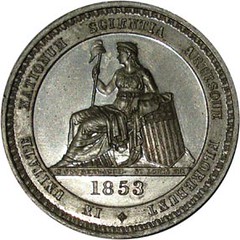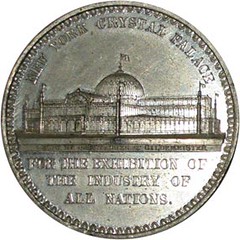
PREV ARTICLE
NEXT ARTICLE
FULL ISSUE
PREV FULL ISSUE
NUMISMATIC VOCABULARY: ITINERANT ENGRAVER
Dick Johnson offers these thoughts on an obscure occupation with a numismatic connection: the itinerant engraver.
-Editor
In the 19th century we observe the existence of hand engravers moving from town to town to ply their craft. Victor Brenner did this in Lithuania before he came to America. In New York City he found ample work in that one city. He only left New York to travel to Paris to study (under Louis Roty), or later, to travel to Maine for a honeymoon or vacations. However in 19th century America there arose the itinerant engraver. The cities of Boston, New York and Philadelphia had full time engravers with full time work. In other cities often the amount of engraving work did not justify an engraver staying put in one local. Thus the hand engraver would pack his bag of burins and chisels and travel around taking what engraving work -- any kind of engraving -- wherever he could find it. It gives true meaning to the term "journeyman." For the most part this was monogramming silverware for wealthy families, but could also include engraving nameplates for doors, pews and coffins. Infrequently this would include cutting a die for a storecard, campaign medal or trade token. And this enterprise becomes evident when we see a list of work of a single engraver whose signed pieces would include tokens and medals for merchants or clients in other than the engraver's known city. Usually the engraver returns to his home city. On rare instances he would relocate permanently. Engraver Charles Stubenrauch worked first in New York City with family members in the jewelry business, relocated to Saint Louis (1859-ca1875) but relocated again to San Antonio, perhaps on such an itinerant trip.


1853 Crystal Palace So-Called Dollar by Charles Stubenrauch Image from www.so-calleddollars.com Another engraver was active in Chicago for the 1892-93 Worlds Fair. Three medals were engraved by engraver Blumenfeld (full name unknown). These were Eglit numbers 21, 321 and 449. Perhaps he caught the fair bug because he shows up the following year in San Francisco for the California Midwinter Exposition, where he engraved medals HK 246 and 247. And this brings to mind a question or two for the collective knowledge of E-Sylum readers. In Chicago he signed his pieces with his name and the enigmatic letters "P.O.C." In San Francisco he added the initials "S.F.C ." to his signature. Questions: What was his full name? And what do these initials stand for?
In addition, Dick has the following numismatic vocabulary comment on an item in last week's issue.
-Editor
From an ANA Press Release: "Numismatic Theatre, held throughout the show, lets ANA members discuss their research and ideas in lecture format. Many talks focus on the convention's host region. This year's presentations include “Engraver and Patriot: Paul Revere, the Man and the Medallion” by convention medal artist Jamie Franki; and an early U. S. minting technology panel discussion with Dr. Richard Doty, Brad Karoleff, R.W. Julian and Douglas Mudd." I am not picking on Jamie Franki, but someone should tell him a "medallion" is greater than 80mm.
The correct term for his Paul Revere medal is "medal."
The Numismatic Bibliomania Society is a non-profit organization promoting numismatic literature. See our web site at coinbooks.org. To submit items for publication in The E-Sylum, write to the Editor at this address: whomren@gmail.com To subscribe go to: https://my.binhost.com/lists/listinfo/esylum All Rights Reserved. NBS Home Page Contact the NBS webmaster 
|